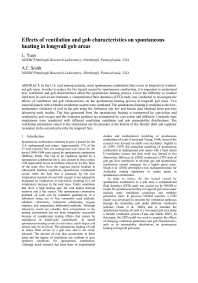Mining Publication: Effects of Ventilation and Gob Characteristics on Spontaneous Heating in Longwall Gob Areas
Original creation date: June 2008
In the U.S. coal mining industry, most spontaneous combustion fires occur in longwall or worked-out gob areas. In order to reduce the fire hazard caused by spontaneous combustion, it is important to understand how ventilation and gob characteristics affect the spontaneous heating process. Given the difficulty to conduct field tests in such an environment, a computational fluid dynamics (CFD) study was conducted to investigate the effects of ventilation and gob characteristics on the spontaneous heating process in longwall gob areas. Two longwall panels with a bleeder ventilation system were simulated. The spontaneous heating is modeled as the low-temperature oxidation of coal in the gob using the Arrhenius rate law and kinetic data obtained from previous laboratory-scale studies. The heat generated from the spontaneous heating is transported by convection and conduction, and oxygen and the oxidation products are transported by convection and diffusion. Unsteady state simulations were conducted with different ventilation conditions and gob permeability distributions. The ventilation parameters varied in the simulations are the pressure at the bottom of the bleeder shaft and regulator resistance in the second entry inby the longwall face.
Authors: L Yuan, AC Smith
Conference Paper - June 2008
NIOSHTIC2 Number: 20034037
Proceedings of the 12th U.S./North American Mine Ventilation Symposium, Reno, Nevada, June 9-11, 2008. Wallace, Jr. KG. ed., Reno, NV: University of Nevada - Reno, 2008; :141-147
See Also
- CFD Modeling of Spontaneous Heating in a Large-Scale Coal Chamber
- Computational Fluid Dynamics Modeling of Spontaneous Heating in Longwall Gob Areas
- Development and Application of Reservoir Models and Artificial Neural Networks for Optimizing Ventilation Air Requirements in Development Mining of Coal Seams
- Effect of Longwall Face Advance on Spontaneous Heating in Longwall Gob Areas
- The Effect of Ventilation on Spontaneous Heating of Coal
- Elastic and Shear Moduli of Coal Measure Rocks Derived from Basic Well Logs Using Fractal Statistics and Radial Basis Functions
- Fire Fighting
- Numerical Study on Effects of Coal Properties on Spontaneous Heating in Longwall Gob Areas
- Simulation of Spontaneous Heating in Longwall Gob Area with a Bleederless Ventilation System
- Spontaneous Combustion
- Stochastic Modeling of Gob Gas Venthole Production Performances in Active and Completed Longwall Panels of Coal Mines
- Page last reviewed: 9/21/2012
- Page last updated: 9/21/2012
- Content source: National Institute for Occupational Safety and Health, Mining Program


 ShareCompartir
ShareCompartir
